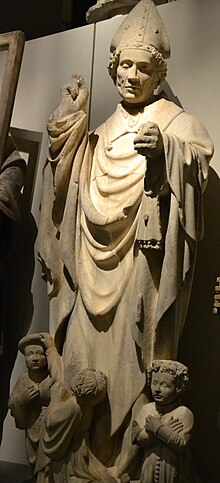This articleneeds additional citations forverification.(November 2024) |
Babylas(Greek:Βαβύλας,fromSyriac:ܒܐܒܘܠܐ,romanized:Babūla;Arabic:بابل;died 253) was aSyrianpatriarch of Antioch(237–253), who died in prison during theDecian persecution.[2]In theEastern Orthodox ChurchandEastern Catholic Churchesof the Byzantine rite his feast day is September 4, in theRoman Rite,January 24. He has the distinction of being the first saint recorded as having had his remains moved or "translated"for religious purposes; a practice that was to become extremely common in later centuries.[3]
Babylas | |
|---|---|
 "San Babila and the three little martyrs",Museo del Duomo di Milano | |
| Died | 253 |
| Venerated in | Eastern Orthodox Church Catholic Church |
| Majorshrine | Cremona,Italy |
| Feast | Eastern Orthodox ChurchandArmenian Apostolic Church,September 4[1] Roman Catholic,January 24 |
Life
editBabylas was the successor of Zebinus as Bishop of Antioch in the reign of the EmperorGordian III(238–244), being the twelfth bishop of the see. During the Decian persecution (250) he made an unwavering confession of faith and was thrown into prison where he died from his sufferings. He was, therefore, venerated as amartyr.[4]
John Chrysostom's homily upon Babylas and theActs of the Martyrsreport the following story, that Babylas once refused the visiting pagan emperor, on account of his sinful ways, permission to enter the church and had ordered him to take his place among the penitents. John does not give the name of the emperor; theActsmentionNumerian.[5]It is more likely the contemporaryPhilip the Arabof whom Eusebius (Historia ecclesiastica,VI, 34) reports that a bishop would not let him enter the gathering of Christians at theEastervigil.[4]Later legend elaborates on this, stating that Babylas demanded that he do penance for his part in the murder of the youngGordian IIIbefore he would allow Philip to celebrate Easter.
Veneration
editIn 351 the CaesarConstantius Gallusbuilt a new church in honor of Babylas atDaphne,a suburb of Antioch, and had the remains of the bishop transferred to it.[4]The intention of Gallus intranslatingthe remains of Babylas to Daphne was to neutralize the pagan effects of the temple ofApollolocated there, or, as Chrysostom expresses it, to "bring a physician to the sick."
According to Chrysostom, when EmperorJulianconsulted the oracle of Apollo at the temple in Daphne (362), he received no answer, and was told that it was because of the proximity of Babylas.[6]He therefore, had the sarcophagus of the martyr exhumed and taken back to his original place of burial.[6]A few days later, on October 22, a mysterious fire broke out in the temple of Apollo, consuming the roof of the building, and the statue of the god,[6]copied fromPhidias' statue of Zeus atOlympia.Julian, suspecting angry Christians were responsible, ordered the cathedral of Antioch closed,[6]and an investigation into the cause of the fire:Ammianus Marcellinusreports "a frivolous rumor" laid the blame to some candles lit by a worshipper late the previous night (XXII, 13). John Chrysostom claimed a bolt of lightning set the temple on fire. The remains of Babylas were reinterred in a church dedicated to him on the other side of the RiverOrontes.Near the close of his discourse John Chrysostom refers to the erection of the church dedicated to Babylas, and to the zeal of the BishopMeletiusin promoting it, who actually took part in the work with his own hands.[citation needed]
This was the first recorded "translation" of the buried remains of a saint, something that was to become routine in theMiddle Ages.
The columns and walls of the ruined temple were still pointed out twenty years later. In the Middle Ages, the remains of Babylas are said to have been moved toCremona.
References
edit- ^Curtin, D. P. (October 2018).The Armenian Synaxarium- Volume I.Dalcassian Press.ISBN9781088279311.
- ^According toEusebius,Historia Ecclesiastica,VI, 39.
- ^Eduard Syndicus;Early Christian Art;p. 73; Burns & Oates, London, 1962
- ^abcKirsch, Johann Peter,"St. Babylas",The Catholic Encyclopedia. Vol. 2. New York: Robert Appleton Company, 1907. 12 Feb. 2014
- ^"Άγιος Βαβύλας ο Ιερομάρτυρας επίσκοπος Αντιοχείας και τα Τρία Παιδιά που μαρτύρησαν μαζί μ' αυτόν Αμμώνιος, Δονάτος και Φαύστος".Διακόνημα(in Greek).Retrieved2024-11-04.
- ^abcdFrendo 2007,p. 86.
Sources
edit- Frendo, David (2007). "Dangerous Ideas: Julian's Persian Campaign, Its Historical Background, Motivation, and Objectives".Bulletin of the Asia Institute.21.